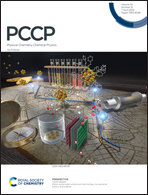Spectroscopic characterization of two boron heterocyclic radicals in the solid neon matrix†
Abstract
Two novel boron heterocyclic radicals, a 3,4,5-trihydroborinine radical and a 1-methyl-2-dihydro-1H-borole radical, were observed in the reaction of boron atom with cyclopentene. These radicals were trapped in solid neon and identified using matrix isolation infrared spectroscopy as well as quantum chemical calculations. The ground-state boron atom selectively inserts into the C![[double bond, length as m-dash]](https://www.rsc.org/images/entities/char_e001.gif) C double bond of cyclopentene forming a 3,4,5-trihydroborinine radical (A). This radical can further isomerize to a 1-methyl-2-dihydro-1H-borole radical (B) under UV light irradiation via multiple hydrogen-atom transfer and rearrangement reactions. The observation of species A and further photo-isomerization to species B is consistent with theoretical predictions that these reactions are thermodynamically exothermic and kinetically facile. This is an exciting example of the synthesis of borole derivatives through multiple hydrogen-atom transfer and rearrangement reactions of borinine compounds induced by light irradiation. The present findings provide new insight into the future design and synthesis of the corresponding boron heterocyclic compounds.
C double bond of cyclopentene forming a 3,4,5-trihydroborinine radical (A). This radical can further isomerize to a 1-methyl-2-dihydro-1H-borole radical (B) under UV light irradiation via multiple hydrogen-atom transfer and rearrangement reactions. The observation of species A and further photo-isomerization to species B is consistent with theoretical predictions that these reactions are thermodynamically exothermic and kinetically facile. This is an exciting example of the synthesis of borole derivatives through multiple hydrogen-atom transfer and rearrangement reactions of borinine compounds induced by light irradiation. The present findings provide new insight into the future design and synthesis of the corresponding boron heterocyclic compounds.



 Please wait while we load your content...
Please wait while we load your content...